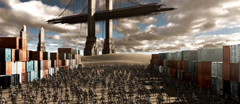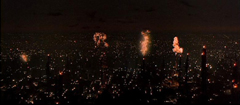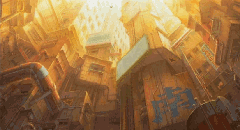
The common contemporary condition of the natural world within urban centres is presented in the portrayal of Chicago in I-Robot. The natural environment is a minor element, not integrated into the urban form but rather is a series isolated instances. Thus, the natural environment cannot be experienced within the urban form. The closest encounter with nature presented in I-Robot is in the final scene, where Sonny stands on a sandy ridge in front of the shipping yard with a sky above illuminated by a setting sun, since it is reminiscent of a classical landscape painting. However, this scene does not contain the primary element of inspiration, the thriving organic life.
In Renaissance 2054, the natural world is even more excluded from the urban environment, presented in only two scenes very briefly. It is shown once in the vestibule to Jonas Muller’s apartment as a thriving forest. The organic environment creates a striking contrast to the urban environment presented in the rest of the movie. It is contained within a box so rather then being part of a thriving organic system contributing to the city, it is a commodity of a privileged citizen. Nature is presented the second time as a virtual simulation. The audience is encouraged to speculate whether the natural environment even exists physically or is it merely an extinct thing of the past which can only be experienced virtually.
The extinction of the organic within the urban environment is presented explicitly in Blade Runner. This condition is presented in the beginning of the movie through the aerial views of an endless urban environment. The extinction of the natural world is reinforced later in the film through the depiction of a replicant owl. The 2001 version of Metropolis speculates a similar urban future since it presents an environment entirely fabricated from manufactured materials.
These depictions
of the future are uncomfortable. First of all, this urban condition is
very believable considering current trends. In addition, we inherently
understand the connection between our origins and the natural world. A
portrayal of a world in which the natural environment is extinct is uncanny
because it is understood that civilization has crossed over a line which
it can never return.










